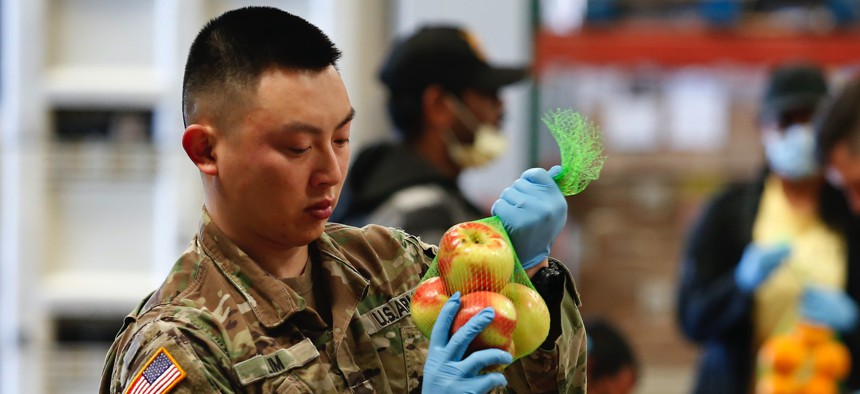
Sgt. Caleb Lim, of the California National Guard ties up a bag of apples at the Sacramento Food Bank and Family Services in Sacramento, Calif., Saturday, March 21, 2020. Rich Pedroncelli/AP
Viewpoint: The Right Way to Activate the National Guard
There are three methods of mobilizing America’s citizen soldiers. Which one Trump chooses will matter a great deal.
In the past couple of days, numerous states have activated members of their respective National Guard forces to provide support to civil authorities trying to contend with the coronavirus pandemic. They are right to do so. The National Guard could contribute much-needed logistics, security, and even direct medical assistance. There have also been indications that the Trump administration has considered “federalizing” the National Guard and bringing it under centralized control.
However, imposing federal planning and operational control over a state’s citizen-soldiers would likely result in a less-than-ideal use of both Guard and active-duty forces, and potentially elevate a raft of political tensions already affecting the response. Thankfully, there’s a better way to deploy America’s guardsmen to help civil authorities fight the coronavirus.
There are essentially three ways a guardsman can be brought into an active status to perform a mission. One method is called “state active duty,” in which the governor activates state Guard members in support of a particular mission. The state must bear the cost, and the members are under the governor’s command.
Another method is when the federal government activates the Guard in what is called Title 10 status—that is what is meant by “federalizing” the Guard. The federal government pays, and activated Guard units are placed under the control of the secretary of defense and the president, with an active-duty military officer in the chain of command.
This method was used for guardsmen activated to support military operations in Iraq and Afghanistan. It was also used for Hurricane Katrina in 2005, during which elements of several states’ National Guard were placed under the command of an active-duty general officer.
This has negative consequences both practical and political. Nobody knows a state like its National Guard. However competent and well meaning, an active officer lacks essential knowledge about the state being supported, including how it is organized for emergency operations, and has no preexisting relationships with the key players. Moreover, placing a federal officer in charge of state resources places the governor in an acutely uncomfortable position politically, to say nothing of potentially developing resentment among the state’s guardsmen.
Related: Coronavirus Halts Military Travel In and Out of Iraq and Afghanistan
Related: China Is Avoiding Blame by Trolling the World
Related: The Prognosis: Latest News on Coronavirus & National Security
Fortunately, the National Guard can be activated in a third way. Under Title 32 status, a guardsman is activated by and remains under the control of the governor, but is paid for by the federal government. This helps relieve the financial burden on the affected state. But it leaves one remaining problem: It does not address the crucial concept of “unity of command,” which is intended to eliminate confusion when military units are operating in the same space, such as when active-duty forces (including medical, mobility, and construction units) are supporting the state as well.
We solved this problem in 2010 by working together to create a new position called the dual-status commander, or DSC. At the time, Admiral Winnefeld was the commander of U.S. Northern Command, and General McKinley was the chief of the National Guard Bureau. We agreed that Northern Command would provide specialized training to a National Guard general officer in each state who, when authorized by the secretary of defense, would be qualified to simultaneously command federal forces (reporting to the secretary) and a state’s National Guard forces (reporting to the governor). This concept has been exercised, and it works.
The DSC solution does four important things. First, it preserves unity of command when a state’s citizens are in the grip of a disaster—or, in this case, a pandemic. Second, it places in overall command an officer who is deeply familiar with the state in question. Third, it enables an officer who is trained in how to employ federal forces to make the best use of them. And finally, it removes all political emotion from the problem—something that is especially important in America’s politically fractured society.
The military has much to offer at a time when America has been placed at grave risk by the coronavirus and COVID-19, the disease it causes. The secretary of defense should authorize appropriate use of Title 32 funding to enable the National Guard to step up to this challenge, as well as authorize the use of DSCs to lead appropriate military efforts—active, Guard, or reserve—within the states.






